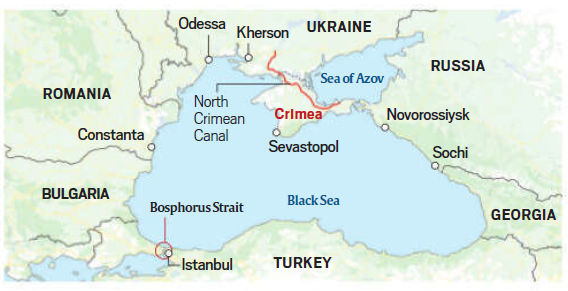26 April 2025 : Daily Current Affairs
1. India, France to finalise ₹63,000-cr. deal for 26 Rafale-M jets on April 28
(Source – The Hindu, International Edition, Page 3)
| Topic: GS Paper 2 – International Relations, GS Paper 3- Defence Technology |
| Context |
|
1. Strategic Significance of the Rafale-M Deal
- Enhancing Naval Air Power:
The Indian Navy’s two aircraft carriers (INS Vikrant and INS Vikramaditya) require reliable, carrier-capable multi-role fighter jets. Rafale-M fits this need with its proven capabilities. - Timeline for Delivery:
Delivery of jets will commence in three-and-a-half years and complete in about six-and-a-half years after signing the contract. - Composition of Purchase:
- 22 Single-Seat Carrier-Compatible Fighters.
- 4 Twin-Seat Trainers (not carrier-compatible but essential for training needs).
- Indigenous Modifications:
Minor adaptations needed for Indian carriers’ lift systems (originally designed for MiG-29Ks) to accommodate Rafale-M jets.
2. Why This Deal Matters for India’s Security Architecture
- Strengthens Carrier Strike Groups (CSGs):
Modern CSGs revolve around air superiority. Rafale-M, with advanced radar, weapon systems, and electronic warfare capabilities, significantly upgrades the Indian Navy’s offensive and defensive reach. - Strategic Autonomy and Diversification:
Reduces over-dependence on Russian MiG-29K fighters, diversifies operational platforms. - Counterbalance in Indo-Pacific:
As tensions rise with China in the Indo-Pacific, enhanced naval aviation capability allows India to project power and ensure maritime security. - Interoperability with Allies:
Operating Rafale-M facilitates closer operational ties with the French Navy and Western allies (e.g., Quad grouping).
3. Financial and Industrial Aspects
- Deal Value:
₹63,000 crore (~$7.5 billion). - Government-to-Government Mode:
Ensures speed, transparency, and reduced litigation compared to open tender systems. - Offsets and Industrial Collaboration:
Likely to involve technology sharing, industrial offsets benefiting Indian defence ecosystem.
4. Broader Defence Modernization Context
- Continuity from IAF Rafale Acquisition:
The Indian Air Force already operates 36 Rafale fighters (₹60,000 crore deal signed in 2016).
Navy’s Rafale-M version will ensure maintenance and training synergies across services. - Focus on Indigenous Carrier Operations:
INS Vikrant, India’s first indigenous aircraft carrier, gains full operational capabilities with Rafale-M induction.
Conclusion
The Rafale-M deal is not just a big-ticket defence acquisition but a critical pivot in India’s naval modernization and maritime strategic calculus. It embodies India’s push for credible deterrence, power projection, and enhanced operational readiness in an increasingly contested Indo-Pacific region.
| Practice Question: “In the context of India’s Rafale-M deal with France, critically analyze how modern defense acquisitions enhance a nation’s maritime security and strategic autonomy. Also discuss the challenges such high-value defense procurements pose for India.” (250 words / 15 marks) |
2. Dhankhar lauds Ravi for holding V-Cs’ conference
(Source – The Hindu, International Edition, Page 2
| Topic: GS Paper 2 – Polity and Governance |
| Context |
|
1. Constitutional Role of Governor in Higher Education
- Governor’s Dual Responsibility:
- As a constitutional head, bound by the oath under Article 159 of the Constitution.
- Role includes preserving, protecting, and defending the Constitution and working for the service and well-being of the people.
- Governor’s Role in Universities:
- Chancellor of State Universities (in many states including Tamil Nadu).
- Exercises powers related to appointments, convocations, and academic administration — a sensitive area often leading to friction with elected state governments.
2. Importance of Educational Conferences
- Forum for Academic Exchange:
Encourages sharing of innovative ideas across universities. - Promotion of Constitutional Values:
Events like these reflect the Governor’s duty to promote education, tolerance, dialogue, and democratic engagement among academic leaders.
3. Vice-President’s Key Messages for Universities
- Encourage Innovation and Cross-Pollination:
Universities must share faculty talent virtually and physically across campuses. - Nurture Tolerance for Divergent Opinions:
True spirit of democracy lies in respecting minority voices and engaging in dialogue without judgment. - Guard Against Intolerance:
Suppression of different views distorts the essence of democracy. - Promote Democratic Ethos in Academia:
Academic spaces must remain open, dynamic, and resilient to the exchange of ideas.
4. Political Undercurrents
- Backdrop of Tussle in Tamil Nadu:
The conference was seen amid tensions between the Tamil Nadu government and the Governor over bills pending for assent and governance issues. - Governors and Higher Education Autonomy:
Debate around whether Governors overstep their role in university administration, raising questions of constitutional morality vs political convenience.
Conclusion
Vice-President Dhankhar’s remarks underline the crucial role of constitutional functionaries like Governors in upholding educational excellence and democratic values. For aspirants, this episode offers deep insights into federal relations, constitutional governance, autonomy of institutions, and ethical leadership.
| Practice Question “Discuss the constitutional role of the Governor in India’s higher education system. In light of recent events, analyze how Governors can balance their constitutional obligations with promoting academic freedom and innovation.” (250 words / 15 marks) |
3. DRDO makes headway in hypersonic technology
(Source – The Hindu, International Edition, Page 2)
| Topic: GS Paper 3 – Defence Technology and Innovations |
| Context |
|
1. What is Hypersonic Technology?
- Definition:
Hypersonic vehicles travel at speeds greater than Mach 5 (i.e., five times the speed of sound, ~6,100 km/h or more). - Scramjet Engines:
- “Supersonic Combustion Ramjet” (Scramjet) engines allow sustained flight at hypersonic speeds.
- They breathe air from the atmosphere, making them lighter and more efficient compared to traditional rockets.
- Active Cooled Combustor:
- Special cooling mechanisms to withstand extremely high thermal loads during hypersonic flight.
- Ensures long-duration performance without material failure.
2. DRDO’s Achievement: Why it is Important
- 1000-Second Ground Test:
- Huge jump from earlier tests limited to about 120 seconds.
- Indicates robust endurance, crucial for real-world weapon applications.
- Towards Hypersonic Cruise Missile:
- Forms the building block for India’s development of hypersonic cruise missiles, both for strategic deterrence and precision strike capabilities.
- Indigenous Capability:
- Reduces dependency on foreign technology in critical defence sectors.
- Strengthens India’s Atmanirbhar Bharat (self-reliance) goals in high-end defence tech.
3. Strategic and Military Relevance
- Next-Generation Warfare:
Hypersonic missiles can evade missile defence systems due to their speed and manoeuvrability. - Counter to Global Developments:
- China (DF-ZF hypersonic glide vehicle) and Russia (Avangard system) already field hypersonic weapons.
- USA also racing to develop operational hypersonic capabilities.
- India’s achievement narrows the technology gap.
- Boosts Second-Strike Capability:
Integrating hypersonic systems into India’s deterrence strategy enhances credibility in future conflict scenarios.
4. Challenges Ahead
- Material Science Limitations:
Need for developing ultra-high temperature ceramics and composites. - Guidance and Navigation:
Hypersonic speeds make precise targeting extremely difficult due to aerodynamic and thermal distortions. - Global Regulatory Environment:
Future restrictions (akin to Missile Technology Control Regime) may tighten on hypersonic tech transfer and deployment.
Conclusion
DRDO’s breakthrough in hypersonic scramjet technology marks a watershed moment for India’s defence research and national security posture. It positions India among the few elite nations developing next-generation strategic capabilities — vital for maintaining a credible and modern deterrence profile in an increasingly volatile global security environment.
| Practice Question: “Hypersonic technologies are reshaping the future of military deterrence and aerospace engineering. Discuss the significance of India’s advancements in hypersonic research for its national security. What are the challenges India must overcome to operationalize this technology?” (250 words / 15 marks) |
4. Trump’s Crimea Proposal Raises Global Fears Over Territorial Integrity
(Source – Indian Express, Section – Explained, Page – 11)
| Topic: GS2 – International Relations |
| Context |
|
Analysis of the news:
 Strategic Importance of Crimea
Strategic Importance of Crimea
- Crimea’s significance lies in its geography. It offers Russia access to the Black Sea and, through the Bosphorus, to the Mediterranean — a centuries-long strategic ambition due to Russia’s lack of warm-water ports.
- The deep-sea port of Sevastopol is central to Russia’s naval capabilities, making Crimea vital to Moscow’s military posture.
Backdrop of the 2014 Annexation
- Russia annexed Crimea after the ouster of pro-Russian Ukrainian President Viktor Yanukovych.
- The move was aimed at preventing Ukraine’s tilt towards NATO and safeguarding Russia’s naval assets in Sevastopol.
- The annexation was swift and strategically preemptive, reflecting Moscow’s security anxieties.
Water Security as a Strategic Driver
- Crimea is water-scarce, and its dependence on the North Crimean Canal—controlled by Ukraine—became a vulnerability after 2014.
- Post-invasion in 2022, Russia demolished a Ukrainian dam to restore water flow, underlining how control over water infrastructure shaped its territorial ambitions, especially in the Kherson region.
Geopolitical Risks of Formal Recognition
- Accepting Crimea’s annexation could embolden other authoritarian regimes, particularly China regarding Taiwan.
- Experts warn it may encourage land grabs globally and signal a retreat from the principle of territorial integrity — a cornerstone of post-WWII international order.
Ukraine’s Stance
- President Volodymyr Zelenskyy has firmly rejected any peace deal that involves territorial concessions.
- Ukraine views such a proposal as unconstitutional and existentially dangerous, fearing it could invite further Russian aggression once Moscow regroups.
| Practice Question: Critically examine the strategic significance of Crimea for Russia and discuss the implications of formal international recognition of its annexation on global norms regarding territorial sovereignty. (250 Words /15 marks) |
5. UDAN Scheme – Connecting India, One Flight at a Time.
(Source – PIB 26th April 2025)
| Topic: GS Paper 2 & 3– Governance, Government Schemes, Infrastructure Development, Economic Growth. |
| Context |
|
1. Evolution and Achievements of UDAN Scheme
- Launch Date: 21 October 2016.
- First Flight: Shimla to Delhi on 27 April 2017.
- Operational Impact:
- 625 routes operationalized.
- 90 airports connected (including 2 water aerodromes and 15 heliports).
- Over 1.49 crore passengers benefited with affordable regional air travel.
- Infrastructure Growth:
- India’s airports increased from 74 in 2014 to 159 in 2024 — more than doubling.
- Financial Support:
- ₹4,023.37 crore disbursed as Viability Gap Funding (VGF) to airlines.
2. Key Components of UDAN
- Viability Gap Funding (VGF):
Financial aid to make flights commercially viable on underserved routes. - Airfare Cap:
Ensures affordable ticket pricing for citizens. - Collaborative Governance:
- Central Government, State Governments, Airport Authority of India (AAI), private operators jointly manage operations.
- Stakeholder Incentives:
- Airport Operators: Waive landing and parking fees.
- AAI: No Terminal Navigation Landing Charges (TNLC).
- Central Government: Caps excise duty on Aviation Turbine Fuel (ATF) at 2% at RCS airports.
- States: Reduce VAT on ATF to 1% or lower for 10 years.
3. Evolution Phases of UDAN Scheme
| UDAN Phase | Key Features |
| UDAN 1.0 (2017) | 128 routes awarded; 36 new airports. |
| UDAN 2.0 (2018) | Inclusion of 73 underserved airports; heliports introduced. |
| UDAN 3.0 (2019) | Tourism routes and seaplane operations initiated. |
| UDAN 4.0 (2020) | Focus on hilly, NE states, and island territories. |
| UDAN 5.5 (2024) | Expansion to 50+ water bodies for seaplanes. |
4. Recent Innovations and Future Vision
- UDAN Yatri Cafes:
Affordable food outlets launched at airports like Kolkata and Chennai. - Seaplane Operations:
- Guidelines issued for 50+ water bodies.
- Focus on boosting last-mile connectivity.
- Revamped UDAN Scheme:
- Target to connect 120 new destinations.
- Enable affordable travel for 4 crore additional passengers over the next decade.
- Krishi UDAN:
- Facilitates air cargo for agricultural produce from remote areas (58 airports involved).
- Airport Infrastructure Push:
- Plan to build 50 new airports in next 5 years.
- Major expansions in Bihar (Patna, Bihta).
5. Socio-Economic Impact of UDAN
- Boost to Regional Tourism:
Enhanced air access led to tourism growth in hill states, coastal towns, and remote regions. - Healthcare Accessibility:
Faster connectivity improved medical emergencies and patient travel to metro cities. - Trade and Agriculture:
Faster movement of goods, perishable agricultural products via Krishi UDAN. - Employment Generation:
Growth of airports and ancillary services created numerous jobs in Tier-2 and Tier-3 cities.
Conclusion
The UDAN Scheme has redefined India’s aviation landscape by making “hawai jahaz” travel affordable for the “hawai chappal” wearer. It embodies inclusive governance, regional empowerment, and infrastructural modernization. Going forward, UDAN’s expansion into hilly terrains, North-East India, and seaplane connectivity symbolizes India’s push toward holistic, equitable national growth.
| Practice Question: “The democratization of air travel through initiatives like UDAN has expanded India’s aviation footprint, but challenges such as infrastructure gaps, financial sustainability, and environmental concerns persist. Critically examine the role of air connectivity in promoting regional development. Suggest a multi-pronged strategy to make India a global aviation hub while ensuring inclusivity and environmental sustainability.” (250 words / 15 marks) |
Prelims Facts
1. India Suspends Indus Treaty; Pakistan Freezes Simla Pact
(Source – Indian Express, Section – Explained , Page – 11)
| Context |
|
Analysis of the news:
India’s Decision to Hold IWT in Abeyance
- India’s move to suspend the Indus Waters Treaty (IWT) is a diplomatic response to the Pahalgam terror attack, targeting Pakistan’s alleged continued support for cross-border terrorism.
- By invoking Article XII (3), India cited “fundamental changes in circumstances” including demographic shifts, clean energy needs, and Pakistan’s lack of good faith.
Legal Standing and Limitations
- Although the term “hold in abeyance” lacks formal recognition under international law, India has tried to justify it within the framework of the Vienna Convention on the Law of Treaties (1969).
- However, the International Court of Justice (ICJ) has historically set a high bar for what qualifies as a “fundamental change,” especially if not directly related to the treaty’s subject matter.
Dispute Resolution Mechanism under IWT
The IWT includes a robust three-tier dispute resolution mechanism:
- Permanent Indus Commission
- Neutral Expert (appointed by the World Bank)
- Permanent Court of Arbitration (PAC)
India has previously challenged Pakistan’s direct recourse to the PAC without exhausting earlier stages. The treaty’s effectiveness remains intact until India gains the infrastructure to redirect water flows.
International Law and Sovereignty
- International law operates on the principle of state consent. India’s decision is more about sending a message to the global community regarding the legitimacy of its actions rather than expecting legal enforcement.
- Sovereign nations can only be held accountable if they submit themselves to international norms.
Simla Agreement: Symbolic, Not Binding
- The 1972 Simla Agreement, meant to ensure peaceful bilateral ties and respect for the Line of Control (LoC), is largely symbolic.
- It carries no enforceable legal obligations and has been repeatedly violated by Pakistan through ceasefire breaches and support for militancy.
- Its practical relevance had already diminished long before Pakistan’s latest announcement.






